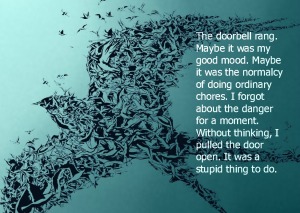Today’s post comes from my writer friend Yvonne Ventresca whose debut YA novel PANDEMIC, hit bookstores in May.
BOOKLIST has this to say about Pandemic:
Five Historical Facts I Learned While Researching a Contemporary Pandemic
By Yvonne Ventresca
My debut young adult novel, Pandemic, is a contemporary story about a teenager struggling to survive a deadly flu pandemic. Although it is set in present-day New Jersey (what would it be like if a pandemic hit suburbia tomorrow?), I spent a lot of time researching the Spanish Flu of 1918 while writing the book. Parts of my fictional disease are based on the historical influenza, and I was interested in finding out as much about it as possible. 
Here are five things I learned while researching Pandemic:
1. The influenza pandemic of 1918 is commonly called the Spanish Flu, but it didn’t originate in Spain. In March of that year, known cases occurred among soldiers in Kansas. But in June, Spain informed the world of a new disease in Madrid, and the Spanish Flu was belatedly named as it spread worldwide.
2. The Spanish flu had a different mortality pattern than previous flu outbreaks, with the highest death rates occurring in adults between the ages of twenty and fifty. The reasons for that pattern are still not entirely understood, but according to the US website Flu.gov, the 1918 virus “evolved directly from a bird flu into a human flu.”
3. In a time before technology, colored ribbons were placed on doorways to indicate a death in the household. The color of the ribbon indicated the age range of the dead. White, for example, was used for children. 
4. In 1918, sanitation measures included wearing face masks, blow-torching water fountains, hosing down streets, and locking public phone booths. Despite these measures, the Spanish flu killed more Americans than all of World War I.
5. Katherine Anne Porter’s short novel, Pale Horse, Pale Rider is set during the 1918 Influenza. It’s a work of fiction (published in 1939), but was no doubt influenced by Porter’s memories of the pandemic and her own illness. The tragic story provides a sense of the war, the disease, and the desperation of that time.
For resources about preparing for an emergency, visit yvonneventresca.com/resources.html.
For more information about the Spanish flu, refer to:
Emerging Epidemics: The Menace of New Infections by Madeline Drexler http://www.goodreads.com/book/show/7444179-emerging-epidemics
The Great Influenza: The Story of the Deadliest Pandemic in History by John M. Barry
http://www.goodreads.com/book/show/29036.The_Great_Influenza
Influenza 1918: The Worst Epidemic in American History by Lynette Iezzoni http://www.goodreads.com/book/show/625882.Influenza_1918
“Pandemic Flu History” http://www.flu.gov/pandemic/history/index.html
Before becoming a children’s writer, Yvonne Ventresca wrote computer programs and taught others how to use technology. Now she happily spends her days writing stories instead of code and sharing technology tips with other writers. Yvonne’s the author of the young adult novel Pandemic, which was published in May from Sky Pony Press. She blogs for teen writers every Tuesday and for writers of all ages each Friday at http://www.yvonneventresca.com/blog.html. 
To connect with Yvonne:
Website: http://www.yvonneventresca.com
Facebook Author http://www.facebook.com/yvonneventrescaauthor
Twitter twitter.com/YvonneVentresca
Goodreads http://www.goodreads.com/author/show/317481.Yvonne_Ventresca
Pinterest: http://www.pinterest.com/yvonneventresca



Yvonne, Very interesting stats about the Spanish flu. The details about the ribbons and colors of the ribbons are rather haunting. Congrats on your novel and much success with it. I look forward to reading it.
Thank you, Robin, and thanks for hosting me Darlene!
Yvonne
It’s taken me all week to get to read this, but smiled when I saw it in my inbox :) VERY fascinating info, Yvonne. It’s frightening to think about, and now we have this ebola scare, right? Finding out something like the ribbons on the doors is the kind of information I love uncovering when I’m reading or researching. I can’t help but wonder if it didn’t make you a bit of a germophobe. I’ve become a bit of one, only because I now get sick so easily!
Great review and info, ladies. Thank you! :)
P.S. Still have PANDEMIC about 2 feet from my bed—-waiting patiently :)